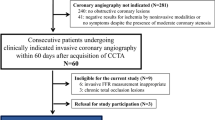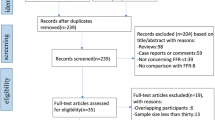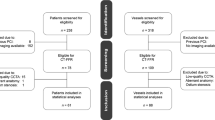Abstract
Objectives
The impact of coronary calcification on the diagnostic accuracy of computed tomography-derived fractional flow reserve (CT-FFR) and coronary computed tomography angiography (CCTA) remains a crucial consideration. This meta-analysis aims to compare the diagnostic performance of CT-FFR and CCTA at different levels of coronary artery calcium score (CACS).
Methods and results
We searched PubMed, Embase, and the Cochrane Library for relevant articles on CCTA, CT-FFR, and invasive fractional flow reserve (FFR). Ten studies were included to evaluate the diagnostic performance of CT-FFR and CCTA at the per-patient and per-vessel levels in four CACS groups. Invasive FFR was used as the reference standard. Except for the CACS ≥ 400 group, the AUC of CT-FFR was higher than those of CCTA in other subgroups of CACS (in CACS < 100 (per-patient, 0.9 (95% CI 0.87–0.92) vs. 0.32 (95% CI 0.28–0.36); per-vessel, 0.92 (95% CI 0.89–0.94) vs. 0.66 (95% CI 0.62–0.7); both p < 0.001), CACS ≥ 100 (per-patient, 0.86 (95% CI 0.82–0.88) vs. 0.44 (95% CI 0.4–0.48); per-vessel, 0.88 (95% CI 0.85–0.9) vs. 0.51 (95% CI 0.46–0.55); both p < 0.001), and CACS < 400 (per-patient, 0.9 (95% CI 0.87–0.93) vs. 0.74 (95% CI 0.7–0.78), p < 0.001; per-vessel, 0.8 (95% CI 0.76–0.83) vs. 0.74 (95% CI 0.7–0.78); p = 0.02)).
Conclusions
CT-FFR demonstrates superior diagnostic performance in low CACS groups (CACS < 400) than CCTA in detecting hemodynamic stenoses in patients with coronary artery disease (CAD).
Clinical relevance statement
Computed tomography-derived fractional flow reserve might be utilized to determine the necessity of invasive coronary angiography in coronary artery disease patients with coronary artery calcium score < 400.
Key Points
• There is a lack of meta-analysis comparing the diagnostic performance of computed tomography-derived fractional flow reserve and coronary computed tomography angiography at different levels of calcification.
• Computed tomography-derived fractional flow reserve only has a better diagnostic performance than coronary computed tomography angiography with low amounts of coronary calcium.
• For the low coronary artery calcium score group, computed tomography-derived fractional flow reserve might be a good non-invasive method to detect hemodynamic stenoses in coronary artery disease patients.


Similar content being viewed by others
Abbreviations
- AUC:
-
Area under the curve
- BMI:
-
Body mass index
- CACS:
-
Coronary artery calcium score
- CAD:
-
Coronary artery disease
- CCTA:
-
Coronary computed tomography angiography
- CFD:
-
Computational fluid dynamics
- CI:
-
Confidence intervals
- CT-FFR:
-
Computed tomography-derived fractional flow reserve
- DOR:
-
Diagnostic odds ratio
- FN:
-
False negative
- FP:
-
False positive
- FFR:
-
Fractional flow reserve
- HR:
-
Heart rate
- ICA:
-
Invasive coronary angiography
- ML:
-
Machine learning
- NLR:
-
Negative likelihood ratio
- PLR:
-
Positive likelihood ratio
- SROC:
-
Summary receiver operating characteristic curve
- TN:
-
True negatives
- TP:
-
True positive
References
Ralapanawa U, Sivakanesan R (2021) Epidemiology and the magnitude of coronary artery disease and acute coronary syndrome: a narrative review. J Epidemiol Glob Health 11(2):169–177. https://doi.org/10.2991/jegh.k.201217.001
Benton SM Jr, Tesche C, De Cecco CN, Duguay TM, Schoepf UJ, Bayer RR 2nd (2018) Noninvasive derivation of fractional flow reserve from coronary computed tomographic angiography: a review. J Thorac Imaging 33(2):88–96. https://doi.org/10.1097/RTI.0000000000000289
Zhuang B, Wang S, Zhao S, Lu M (2020) Computed tomography angiography-derived fractional flow reserve (CT-FFR) for the detection of myocardial ischemia with invasive fractional flow reserve as reference: systematic review and meta-analysis. Eur Radiol 30(2):712–725. https://doi.org/10.1007/s00330-019-06470-8
Tang CX, Wang YN, Zhou F et al (2019) Diagnostic performance of fractional flow reserve derived from coronary CT angiography for detection of lesion-specific ischemia: a multi-center study and meta-analysis. Eur J Radiol 116:90–97. https://doi.org/10.1016/j.ejrad.2019.04.011
Baumann S, Renker M, Hetjens S et al (2016) Comparison of coronary computed tomography angiography-derived vs invasive fractional flow reserve assessment: meta-analysis with subgroup evaluation of intermediate stenosis. Acad Radiol 23(11):1402–1411. https://doi.org/10.1016/j.acra.2016.07.007
Nørgaard BL, Leipsic J, Gaur S et al (2014) Diagnostic performance of noninvasive fractional flow reserve derived from coronary computed tomography angiography in suspected coronary artery disease: the NXT trial (Analysis of Coronary Blood Flow Using CT Angiography: Next Steps). J Am Coll Cardiol 63(12):1145–1155. https://doi.org/10.1016/j.jacc.2013.11.043
Coenen A, Kim YH, Kruk M et al (2018) Diagnostic accuracy of a machine-learning approach to coronary computed tomographic angiography-based fractional flow reserve: result from the MACHINE Consortium. Circ Cardiovasc Imaging 11(6):e007217. https://doi.org/10.1161/CIRCIMAGING.117.007217
van Hamersvelt RW, Voskuil M, de Jong PA, Willemink MJ, Išgum I, Leiner T (2019) Diagnostic performance of on-site coronary CT angiography-derived fractional flow reserve based on patient-specific lumped parameter models. Radiol Cardiothorac Imaging 1(4):e190036. https://doi.org/10.1148/ryct.2019190036
Tesche C, Otani K, De Cecco CN et al (2020) Influence of coronary calcium on diagnostic performance of machine learning CT-FFR: results from MACHINE Registry. JACC Cardiovasc Imaging 13(3):760–770. https://doi.org/10.1016/j.jcmg.2019.06.027
Li Y, Yu M, Dai X et al (2019) Detection of hemodynamically significant coronary stenosis: CT myocardial perfusion versus machine learning CT fractional flow reserve. Radiology 293(2):305–314. https://doi.org/10.1148/radiol.2019190098
Di Jiang M, Zhang XL, Liu H et al (2021) The effect of coronary calcification on diagnostic performance of machine learning-based CT-FFR: a Chinese multicenter study. Eur Radiol 31(3):1482–1493. https://doi.org/10.1007/s00330-020-07261-2
Koo HJ, Kang JW, Kang SJ et al (2021) Impact of coronary calcium score and lesion characteristics on the diagnostic performance of machine-learning-based computed tomography-derived fractional flow reserve. Eur Heart J Cardiovasc Imaging 22(9):998–1006. https://doi.org/10.1093/ehjci/jeab062
Kamo Y, Fujimoto S, Nozaki YO et al (2021) Incremental diagnostic value of CT fractional flow reserve using subtraction method in patients with severe calcification: a pilot study. J Clin Med 10(19):4398. Published 2021 Sep 26. https://doi.org/10.3390/jcm10194398
Tao Y, Gao Y, Wu X et al (2022) Diagnostic performance of coronary computed tomography (CT) angiography derived fractional flow reserve (CTFFR) in patients with coronary artery calcification: insights from multi-center experiments in China. Ann Transl Med 10(14):788. https://doi.org/10.21037/atm-22-3180
Mickley H, Veien KT, Gerke O et al (2022) Diagnostic and clinical value of FFRCT in stable chest pain patients with extensive coronary calcification: the FACC Study. JACC Cardiovasc Imaging 15(6):1046–1058. https://doi.org/10.1016/j.jcmg.2021.12.010
Nasir K, Rubin J, Blaha MJ et al (2012) Interplay of coronary artery calcification and traditional risk factors for the prediction of all-cause mortality in asymptomatic individuals. Circ Cardiovasc Imaging 5(4):467–473. https://doi.org/10.1161/CIRCIMAGING.111.964528
Yeboah J, Young R, McClelland RL et al (2016) Utility of nontraditional risk markers in atherosclerotic cardiovascular disease risk assessment. J Am Coll Cardiol 67(2):139–147. https://doi.org/10.1016/j.jacc.2015.10.058
Schepis T, Gaemperli O, Koepfli P et al (2007) Added value of coronary artery calcium score as an adjunct to gated SPECT for the evaluation of coronary artery disease in an intermediate-risk population. J Nucl Med 48(9):1424–1430. https://doi.org/10.2967/jnumed.107.040758
Hoffmann MH, Shi H, Schmitz BL et al (2005) Noninvasive coronary angiography with multislice computed tomography. JAMA 293(20):2471–2478. https://doi.org/10.1001/jama.293.20.2471
Zhang S, Levin DC, Halpern EJ, Fischman D, Savage M, Walinsky P (2008) Accuracy of MDCT in assessing the degree of stenosis caused by calcified coronary artery plaques. AJR Am J Roentgenol 191(6):1676–1683. https://doi.org/10.2214/AJR.07.4026
Pugliese F, Mollet NR, Runza G et al (2006) Diagnostic accuracy of non-invasive 64-slice CT coronary angiography in patients with stable angina pectoris. Eur Radiol 16(3):575–582. https://doi.org/10.1007/s00330-005-0041-0
Andrew M, John H (2015) The challenge of coronary calcium on coronary computed tomographic angiography (CCTA) scans: effect on interpretation and possible solutions. Int J Cardiovasc Imaging 31(Suppl 2):145–157. https://doi.org/10.1007/s10554-015-0773-0
Han D, Lin A, Gransar H, Dey D, Berman DS (2021) Influence of coronary artery calcium score on computed tomography-derived fractional flow reserve: a meta-analysis. JACC Cardiovasc Imaging 14(3):702–703. https://doi.org/10.1016/j.jcmg.2020.09.022
Nørgaard BL, Gaur S, Leipsic J et al (2015) Influence of coronary calcification on the diagnostic performance of CT angiography derived FFR in coronary artery disease: a substudy of the NXT Trial. JACC Cardiovasc Imaging 8(9):1045–1055. https://doi.org/10.1016/j.jcmg.2015.06.003
Itu L, Rapaka S, Passerini T et al (2016) A machine-learning approach for computation of fractional flow reserve from coronary computed tomography. J Appl Physiol (1985) 121(1):42–52. https://doi.org/10.1152/japplphysiol.00752.2015
Hlatky MA, De Bruyne B, Pontone G et al (2015) Quality-of-life and economic outcomes of assessing fractional flow reserve with computed tomography angiography: PLATFORM. J Am Coll Cardiol 66(21):2315–2323. https://doi.org/10.1016/j.jacc.2015.09.051
Yang J, Shan D, Wang X et al (2023) On-site computed tomography-derived fractional flow reserve to guide the management of patients with stable coronary artery disease: the TARGET Randomized Trial. Circulation 147(18):1369–1381. https://doi.org/10.1161/CIRCULATIONAHA.123.063996
Acknowledgements
The authors thank Ziyu An and Jingwen Yong, who helped for initial data analysis. During the revision process, we are very grateful that the biostatistician Zhechun Zhen provided guidance on the statistical section.
Funding
This study has received funding by the Beijing Nova Program (Z211100002121056).
Author information
Authors and Affiliations
Corresponding authors
Ethics declarations
Guarantor
The scientific guarantor of this publication is Xiantao Song.
Conflict of interest
The authors of this manuscript declare no relationships with any companies, whose products or services may be related to the subject matter of the article.
Statistics and biometry
Baoen Zhang and Chenchen Tu extracted the data independently and Hongjia Zhang resolved discrepancies to reach a consensus. Dongfeng Zhang and Zhechun Zhen kindly provided statistical advice for this manuscript.
Informed consent
Not applicable.
Ethical approval
Not applicable.
Study subjects or cohorts overlap
Not applicable.
Methodology
• Meta-analysis
Additional information
Publisher's note
Springer Nature remains neutral with regard to jurisdictional claims in published maps and institutional affiliations.
Zhao Ma and Chenchen Tu are first authors.
Supplementary Information
Below is the link to the electronic supplementary material.
Rights and permissions
Springer Nature or its licensor (e.g. a society or other partner) holds exclusive rights to this article under a publishing agreement with the author(s) or other rightsholder(s); author self-archiving of the accepted manuscript version of this article is solely governed by the terms of such publishing agreement and applicable law.
About this article
Cite this article
Ma, Z., Tu, C., Zhang, B. et al. A meta-analysis comparing the diagnostic performance of computed tomography-derived fractional flow reserve and coronary computed tomography angiography at different levels of coronary artery calcium score. Eur Radiol (2024). https://doi.org/10.1007/s00330-024-10591-0
Received:
Revised:
Accepted:
Published:
DOI: https://doi.org/10.1007/s00330-024-10591-0




